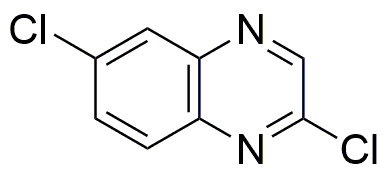2,6-Dichloroquinoxaline is widely utilized in research focused on:
- Pharmaceutical Development: This compound serves as a key intermediate in the synthesis of various pharmaceuticals, particularly in developing anti-cancer and anti-inflammatory drugs.
- Agricultural Chemistry: It is used in formulating agrochemicals, including fungicides and herbicides, to enhance crop protection and yield.
- Material Science: The compound is explored for its potential in creating advanced materials, such as polymers and coatings, due to its unique chemical properties.
- Biochemical Research: Researchers utilize it to study enzyme inhibition and receptor interactions, aiding in the understanding of biological pathways and disease mechanisms.
- Analytical Chemistry: It acts as a standard reference material in analytical methods, helping to ensure accuracy and reliability in chemical analysis.
General Information
Properties
Safety and Regulations
Applications
2,6-Dichloroquinoxaline is widely utilized in research focused on:
- Pharmaceutical Development: This compound serves as a key intermediate in the synthesis of various pharmaceuticals, particularly in developing anti-cancer and anti-inflammatory drugs.
- Agricultural Chemistry: It is used in formulating agrochemicals, including fungicides and herbicides, to enhance crop protection and yield.
- Material Science: The compound is explored for its potential in creating advanced materials, such as polymers and coatings, due to its unique chemical properties.
- Biochemical Research: Researchers utilize it to study enzyme inhibition and receptor interactions, aiding in the understanding of biological pathways and disease mechanisms.
- Analytical Chemistry: It acts as a standard reference material in analytical methods, helping to ensure accuracy and reliability in chemical analysis.
Documents
Safety Data Sheets (SDS)
The SDS provides comprehensive safety information on handling, storage, and disposal of the product.
Product Specification (PS)
The PS provides a comprehensive breakdown of the product’s properties, including chemical composition, physical state, purity, and storage requirements. It also details acceptable quality ranges and the product's intended applications.
Certificates of Analysis (COA)
Search for Certificates of Analysis (COA) by entering the products Lot Number. Lot and Batch Numbers can be found on a product’s label following the words ‘Lot’ or ‘Batch’.
Numéro de catalogue
Numéro de lot/série
Certificates Of Origin (COO)
This COO confirms the country where the product was manufactured, and also details the materials and components used in it and whether it is derived from natural, synthetic, or other specific sources. This certificate may be required for customs, trade, and regulatory compliance.
Numéro de catalogue
Numéro de lot/série
Safety Data Sheets (SDS)
The SDS provides comprehensive safety information on handling, storage, and disposal of the product.
DownloadProduct Specification (PS)
The PS provides a comprehensive breakdown of the product’s properties, including chemical composition, physical state, purity, and storage requirements. It also details acceptable quality ranges and the product's intended applications.
DownloadCertificates of Analysis (COA)
Search for Certificates of Analysis (COA) by entering the products Lot Number. Lot and Batch Numbers can be found on a product’s label following the words ‘Lot’ or ‘Batch’.
Numéro de catalogue
Numéro de lot/série
Certificates Of Origin (COO)
This COO confirms the country where the product was manufactured, and also details the materials and components used in it and whether it is derived from natural, synthetic, or other specific sources. This certificate may be required for customs, trade, and regulatory compliance.


